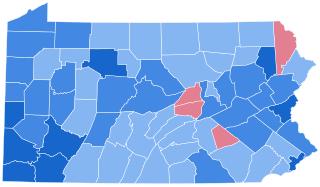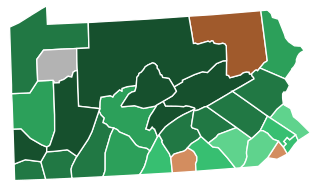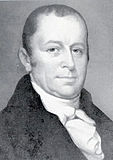
Thomas McKean was an American lawyer, politician, and Founding Father. During the American Revolution, he was a Delaware delegate to the Continental Congress in Philadelphia, where he signed the Continental Association, the Declaration of Independence, and the Articles of Confederation. McKean served as a President of Congress.

Presidential elections were held in the United States from November 4 to December 7, 1796, when electors throughout the United States cast their ballots. It was the first contested American presidential election, the first presidential election in which political parties played a dominant role, and the only presidential election in which a president and vice president were elected from opposing tickets. Incumbent vice president John Adams of the Federalist Party defeated former secretary of state Thomas Jefferson of the Democratic-Republican Party.

Presidential elections were held in the United States from November 4 to December 7, 1808. The Democratic-Republican candidate James Madison defeated Federalist candidate Charles Cotesworth Pinckney decisively.

Presidential elections were held in the United States from October 30 to December 2, 1812. In the shadow of the War of 1812, incumbent Democratic-Republican President James Madison defeated DeWitt Clinton, the lieutenant governor of New York and mayor of New York City, who drew support from dissident Democratic-Republicans in the North as well as Federalists. It was the first presidential election to be held during a major war involving the United States.

Presidential elections were held in the United States from November 1 to December 4, 1816. In the first election following the end of the War of 1812, Democratic-Republican candidate James Monroe defeated Federalist Rufus King. The election was the last in which the Federalist Party fielded a presidential candidate.

Simon Snyder was the third governor of Pennsylvania, serving three terms from 1808 to 1817. He led the state through the War of 1812.

The 1808–09 United States House of Representatives elections were held on various dates in various states between April 26, 1808, and May 5, 1809. Each state set its own date for its elections to the House of Representatives before the first session of the 11th United States Congress convened on May 22, 1809. They coincided with James Madison being elected as president. Elections were held for all 142 seats, representing 17 states.

The 1810 New York gubernatorial election was held in April 1810. Governor Daniel D. Tompkins was elected to a second term in office over Jonas Platt.

The 1799 Pennsylvania gubernatorial election was between two candidates. Incumbent governor Thomas Mifflin was not running. The race was between Federalist U.S. Senator James Ross and Democratic-Republican Thomas McKean. The retired Chief Justice of the Pennsylvania Supreme Court, McKean was a Federalist and a Mifflin ally, as both supported strong state executive power but rejected the domestic policies of the national government.

The 1964 United States presidential election in Pennsylvania took place on November 3, 1964, and was part of the 1964 United States presidential election. Voters chose 29 representatives to the Electoral College, who voted for president and vice president. Pennsylvania overwhelmingly voted for the Democratic nominee, President Lyndon B. Johnson, over the Republican nominee, Senator Barry Goldwater. Johnson won Pennsylvania by a margin of 30.22%. Apart from William Howard Taft in 1912, Goldwater's 34.7% of the vote is easily the worst showing for a Republican in the state since the party was founded. Even relative to Johnson's popular vote landslide, Pennsylvania came out as 7.64% more Democratic than the nation at-large; the only occasion under the current two-party system that the state has been more anomalously Democratic than this was in Ronald Reagan's 1984 landslide.

Elections to the United States House of Representatives were held in Pennsylvania on October 14, 1806, for the 10th Congress.

Elections to the United States House of Representatives were held in Pennsylvania on October 9, 1810, for the 12th Congress. The Federalists were in decline in Pennsylvania at this time. In six of the eleven districts there were no Federalist candidates.

Elections to the United States House of Representatives were held in Pennsylvania on October 11, 1808, for the 11th Congress.

The 1820 Pennsylvania gubernatorial election occurred on October 10, 1820. Incumbent Democratic-Republican governor William Findlay sought re-election but was defeated by U.S. Representative Joseph Hiester. Findlay entered the race with significantly reduced popularity. He had been renounced in the press as an opponent of democracy due to his nomination during the 1817 campaign by a group of party insiders. He additionally faced allegations of corruption over the misappropriation of funds during his tenure as State Treasurer, although all charges were dismissed during impeachment proceedings before the State Legislature. For this campaign, Findlay was nominated at a popular convention of Democratic Republicans; Hiester was selected at a separate convention of Federalists and "Old School Democrats". The sour state of the economy was a key factor in the defeat of the incumbent, as Pennsylvania was reeling from the effects of the Panic of 1819.

The 1817 Pennsylvania gubernatorial election occurred on October 14, 1817. Incumbent Democratic-Republican governor Simon Snyder was not a candidate for re-election. Simon's preferred successor, State Treasurer William Findlay, was nominated as the Democratic Republican candidate by a caucus of legislative leaders. Conversely, U.S. Representative Joseph Hiester was chosen as a candidate by the Democratic Republicans' first popular nominating convention; he additionally gained the endorsement of the declining Federalists.

The 1814 Pennsylvania gubernatorial election occurred on October 11, 1814. After contemplating retirement, incumbent Democratic-Republican governor Simon Snyder instead chose to run for reelection. He earned a third term as the state's executive after defeating Federalist candidate Isaac Wayne, a former member of the Pennsylvania State Senate.

The 1811 Pennsylvania gubernatorial election occurred on October 8, 1811. Incumbent Democratic-Republican governor Simon Snyder won re-election over Federalist candidate William Tilghman, the Chief Justice of the Pennsylvania Supreme Court, by a wide margin. Two of the major policy goals on which Snyder campaigned were increasing spending for infrastructural upgrades and authorizing the transfer of governmental operations from Lancaster to Harrisburg.

The 1805 Pennsylvania gubernatorial election occurred on October 8, 1805. Incumbent governor Thomas McKean won a contentious election over the endorsed Democratic-Republican candidate, Speaker of the Pennsylvania House of Representatives Simon Snyder.

The 1802 Pennsylvania gubernatorial election occurred on October 12, 1802. Incumbent Democratic-Republican governor Thomas McKean successfully sought re-election to another term. As occurred in his prior campaign, he defeated U.S. Senator James Ross, a Federalist.

The 1808 New Hampshire gubernatorial election was held on March 8, 1808.





















